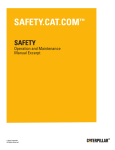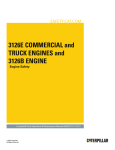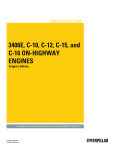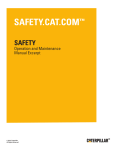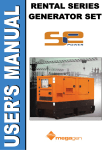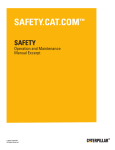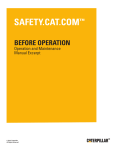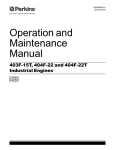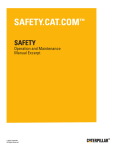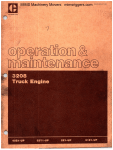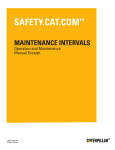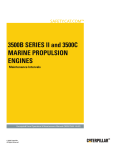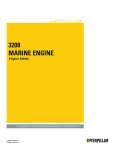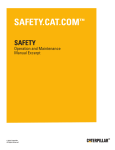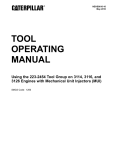Download Service Manual
Transcript
SENR7733-09 December 2004 Service Manual General Service and Repair Safety Information All Caterpillar Machines i01658146 Important Safety Information Most accidents that involve product operation, maintenance and repair are caused by failure to observe basic safety rules or precautions. An accident can often be avoided by recognizing potentially hazardous situations before an accident occurs. A person must be alert to potential hazards. This person should also have the necessary training, skills and tools to perform these functions properly. Improper operation, lubrication, maintenance or repair of this product can be dangerous and could result in injury or death. Do not operate or perform any lubrication, maintenance or repair on this product, until you have read and understood the operation, lubrication, maintenance and repair information. Safety precautions and warnings are provided in this manual and on the product. If these hazard warnings are not heeded, bodily injury or death could occur to you or to other persons. The hazards are identified by the “Safety Alert Symbol” and followed by a “Signal Word” such as “DANGER”, “WARNING” or “CAUTION”. The Safety Alert “WARNING” label is shown below. The meaning of this safety alert symbol is as follows: Attention! Become Alert! Your Safety is Involved. The message that appears under the warning explains the hazard and can be either written or pictorially presented. Operations that may cause product damage are identified by “NOTICE” labels on the product and in this publication. Caterpillar cannot anticipate every possible circumstance that might involve a potential hazard. The warnings in this publication and on the product are, therefore, not all inclusive. If a tool, procedure, work method or operating technique that is not specifically recommended by Caterpillar is used, you must satisfy yourself that it is safe for you and for others. You should also ensure that the product will not be damaged or be made unsafe by the operation, lubrication, maintenance or repair procedures that you choose. The information, specifications, and illustrations in this publication are on the basis of information that was available at the time that the publication was written. The specifications, torques, pressures, measurements, adjustments, illustrations, and other items can change at any time. These changes can affect the service that is given to the product. Obtain the complete and most current information before you start any job. Caterpillar dealers have the most current information available. When replacement parts are required for this product Caterpillar recommends using Caterpillar replacement parts or parts with equivalent specifications including, but not limited to, physical dimensions, type, strength and material. Failure to heed this warning can lead to premature failures, product damage, personal injury or death. SENR7733-09 Table of Contents Systems Operation Section Safety Information ................................................. 4 Index Section Index ..................................................................... 13 3 Table of Contents 4 Systems Operation Section SENR7733-09 Systems Operation Section i02145477 Safety Information SMCS Code: 7000 Introduction Proper repair is important to the safe operation and the reliable operation of this machine. This document outlines basic recommended procedures. Some of the procedures require special tools, devices, or work methods. Before you perform any repairs or before you perform any maintenance, read all safety information. Understand all safety information before you perform any repairs or before you perform any maintenance. Safety information can be found in this document and the following documents for your machine: • Operation and Maintenance Manual Safety Messages There are several specific safety messages on this machine. The exact location of the hazards and the description of the hazards are reviewed in this section. Please become familiarized with all safety messages. Make sure that all of the safety messages are legible. Clean the safety messages or replace the safety messages if you cannot read the words. Replace the illustrations if the illustrations are not legible. When you clean the safety messages, use a cloth, water, and soap. Do not use solvent, gasoline, or other harsh chemicals to clean the safety messages. Solvents, gasoline, or harsh chemicals could loosen the adhesive that secures the safety messages. Loose adhesive will allow the safety messages to fall. Replace any safety message that is damaged, or missing. If a safety message is attached to a part that is replaced, install a safety message on the replacement part. Any Caterpillar dealer can provide new safety messages. Protective Equipment • Testing and Adjusting Manual • Disassembly and Assembly Manual • Warning labels that are located on the machine and engine If these hazard warnings are not heeded, bodily injury or death could occur to you or other persons. Basic Precautions Illustration 1 Improper operation, lubrication, maintenance or repair of this product can be dangerous and could result in injury or death. Do not operate or perform any lubrication, maintenance or repair on this product, until you have read and understood the operation, lubrication, maintenance and repair information. Always observe the list of basic precautions that follows: g00702020 When you work around the machine, always wear protective equipment that is required by the job conditions. Protective equipment includes the items that follow: hard hat, protective glasses, and protective shoes. In particular, wear protective glasses when you use a hammer or when you use a sledge hammer. When you weld use the appropriate protective equipment that is required by the job conditions. Protective equipment for welding includes the items that follow: gloves, welding hood, goggles, and apron. Do not wear loose clothing or jewelry that can catch on parts of the machine. SENR7733-09 5 Systems Operation Section Mounting and Dismounting Make sure that all chains, hooks, slings, and any other lifting devices are in good condition. Ensure that the hooks are equipped with a safety latch. Do not place a side load on the lifting eyes during a lifting operation. Illustration 2 g00037860 Use steps and handholds whenever you mount the machine. Use steps and handholds whenever you dismount the machine. Before you mount the machine, clean the step and the handholds. Inspect the step and handholds. Make all necessary repairs. Face the machine whenever you mount the machine and whenever you dismount the machine. Maintain a three-point contact with the step and with handholds. Note: Three-point contact can be two feet and one hand. Three-point contact can also be one foot and two hands. Do not mount a moving machine. Do not dismount a moving machine. Never jump off the machine. Do not try to mount the machine when you carry tools or supplies. Do not try to dismount the machine when you are carrying tools or supplies. Use a hand line to pull equipment onto the platform. Do not use any controls as handholds when you enter the operator station or when you exit the operator station. Lifting If any component that weighs more than 23 kg (50 lb) is lifted, a hoist should be used. If any component is difficult to move due to the size, the grip, or any other difficulties, a hoist should be used. Specifications for Cables, Chains, and Lifting Devices Use approved cables, chains, and lifting devices in order to lift components. Refer to the manufacturer’s weight’s in order to determine the application when you select the following items: cable, chain, and lifting devices. When you lift a component, the lift angle is critical. Refer to the Illustration that follows in order to see the effect of the lift angle on the working load limit. Note: The lifting devices that are shown in this publication are not Caterpillar parts. Illustration 3 g00629745 Lift angles for lifting slings. (A) The load capacity is 100% of the working load limit for the sling. (B) The load capacity is 86% of the working load limit for the sling. (C) The load capacity is 70% of the working load limit for the sling. (D) The load capacity is 50% of the working load limit for the sling. Hot Fluids and Parts To avoid burns, be alert for hot parts on machines which have just been stopped and hot fluids in lines, tubes and compartments. Be careful when you remove filler caps, breathers and plugs on the machine. Hold a rag over the cap or plug in order to prevent being sprayed by pressurized liquids. When the machine has just been stopped, the possibility of hot fluids is greater. Corrosion Inhibitor Corrosion inhibitor contains alkali. Avoid contact with the eyes. Do not allow corrosion inhibitor to contact the skin for extended periods of time. Avoid repeated contact with the skin. Do not drink corrosion inhibitor. In case of contact, immediately wash skin with soap and water. For contact with the eyes, flush the eyes with large amounts of water for at least 15 minutes. Seek medical attention. 6 Systems Operation Section SENR7733-09 Batteries Do not smoke when an inspection of the battery electrolyte level is made. Never disconnect any charging unit circuit or battery circuit cable from the battery when the charging unit is operating. A spark can cause an explosion from the flammable vapor mixture of hydrogen and oxygen that is released from the electrolyte through the battery outlets. Do not allow battery electrolyte to make contact with the skin or with the eyes. Battery electrolyte is an acid. In case of contact with battery electrolyte, immediately wash the skin with soap and water. For contact with the eyes, flush the eyes with large amounts of water for at least 15 minutes. Seek medical attention. Pressurized Items Pressure can be trapped in a hydraulic system. Releasing trapped pressure can cause sudden machine movement or attachment movement. Use caution if you disconnect hydraulic lines or fittings. High pressure oil that is released can cause a hose to whip. High pressure oil that is released can cause oil to spray. Fluid penetration can cause serious injury and possible death. Pressure can be trapped in the hydraulic circuit long after the engine has been stopped. The pressure can cause hydraulic fluid or items such as pipe plugs to escape rapidly if the pressure is not relieved correctly. Do not remove any hydraulic components or parts until pressure has been relieved or personal injury may occur. Do not disassemble any hydraulic components or parts until pressure has been relieved or personal injury may occur. Refer to the Service Manual for any procedures that are required to relieve the hydraulic pressure. Illustration 4 g00687600 Always use a board or a piece of cardboard when you check for a leak. Leaking fluid under pressure can penetrate body tissue. Fluid penetration can cause serious injury and possible death. A pin hole leak can cause severe injury. If fluid is injected into your skin, you must get treatment immediately. Seek treatment from a doctor that is familiar with this type of injury. Relieve all pressure in air, oil or water systems before any lines, fittings or related items are disconnected or removed. Always make sure that all raised components are blocked correctly. Be alert for possible pressure when you disconnect any device from a system that utilizes pressure. Fuel lines that are damaged and fuel lines that are loose may leak. This could result in a fire if the fluid comes in contact with a source of ignition. Lubrication lines that are damaged and lubrication lines that are loose can leak. This could result in a fire if the fluid comes in contact with a source of ignition. Hydraulic lines, tubes, and hoses that are damaged can leak. This could result in a fire if the fluid comes in contact with a source of ignition. Hydraulic lines, tubes, and hoses that are loose can leak. This could result in a fire if the fluid comes in contact with a source of ignition. Do not bend or strike high pressure lines. Do not install lines which have been bent or damaged. Check lines, tubes and hoses carefully. Do not use your bare hand to check for leaks. If fluids are injected into your skin, you must get treatment immediately. Seek treatment from a doctor that is familiar with this type of injury. Pressure air or water can cause personal injury. When pressure air or water is used for cleaning, wear a protective face shield, protective clothing, and protective shoes. The maximum air pressure for cleaning purposes must be below 205 kPa (30 psi). When you use a pressure washer, keep in mind that the nozzle pressures are very high. The nozzle pressures are frequently above 13790 kPa (2000 psi). Follow all of the recommended practices that are provided by the manufacturer of the pressure washer. SENR7733-09 7 Systems Operation Section General Hazard Information Use all cleaning solutions with care. Report all necessary repairs. Do not allow unauthorized personnel on the equipment. Disconnect the battery and discharge any capacitors before starting work on the machine. Do not work on any machine that is supported only by lift jacks or a hoist. Always use blocks or jack stands in order to support the machine before performing any service of disassembly. Illustration 5 g00104545 Attach a “Do Not Operate” warning tag or a similar warning tag to the start switch or to the controls before you service the equipment or before you repair the equipment. These warning tags (Special Instruction, SEHS7332) are available from your Caterpillar dealer. When possible, make all repairs with the machine parked on a level, hard surface. The machine should be blocked in order to prevent the machine from rolling. Know the width of your equipment in order to maintain proper clearance when you operate the equipment near fences or near boundary obstacles. Be aware of high voltage power lines and power cables that are buried. If the machine comes in contact with these hazards, serious injury or death may occur from electrocution. Make sure that all protective guards and all covers are secured in place on the equipment. If a guard, a cover, or a shield must be removed in order to perform the repair work, use extra caution. Keep the equipment free from foreign material. Remove debris, oil, tools, and other items from the deck, from walkways, and from steps. Secure all loose items such as lunch boxes, tools, and other items that are not a part of the equipment. Know the appropriate work site hand signals and the personnel that are authorized to give the hand signals. Accept hand signals from one person only. Do not smoke when you service an air conditioner. Also, do not smoke if refrigerant gas may be present. Inhaling the fumes that are released from a flame that contacts air conditioner refrigerant can cause bodily harm or death. Inhaling gas from air conditioner refrigerant through a lighted cigarette can cause bodily harm or death. Make sure that the work area around the machine is safe and be aware of any hazardous conditions that may exist. If an engine is started inside an enclosure, make sure that the engine’s exhaust is properly vented. Always use tools that are in good working condition. Ensure that you understand the proper use of the tools before performing any service work. Replace all fasteners with the same part number. Do not use a lesser quality fastener if replacements are necessary. You should be prepared to stop an engine that has been recently overhauled. You should also be prepared to stop the machine if the fuel system has been recently worked on. If the engine has not been assembled correctly or if the fuel setting is not adjusted properly , the engine can possibly overspeed. This may cause bodily injury, death or property damage. You should be prepared to shut off the fuel and air supply to the engine in order to stop the engine. Caution should be used when any cover plate is removed. Slowly back off the last two bolts or the last two nuts that are located at opposite ends of the cover or device. Then, pry the cover loose in order to relieve any spring or other pressure, before removing the last two bolts or nuts completely. Repairs that require welding should be performed only with the benefit of the appropriate reference information. Repairs that require welding should be performed only by personnel that are adequately trained and knowledgeable in welding procedures. Refer to Instruction Manual, SEGV2549, “Techniques of Structural Repair Course”. The type of metal that is being welded should be determined prior to making any repairs. The correct procedures and materials should be used in order to provide a weld that is equivalent in strength to the parent material. 8 Systems Operation Section Do not damage wiring during the removal operations. Wiring should be reinstalled so that the wiring is not damaged. Wiring should also be installed so that the wiring will not be damaged during normal operation of the equipment. Do not connect wiring to a line that may contain fluid. Always use lift arm supports in order to keep the lift arms raised. Keep all work tools tilted downward when repair work is being formed with the lift arms in the raised position. Prior to performing any maintenance or repairs, ensure that all hydraulic pressure has been relieved. SENR7733-09 Refer to Special Publication, NENG2500, “Tools and Shop Products Guide” for the following items: • Tools that are suitable for collecting fluids and equipment that is suitable for collecting fluids • Tools that are suitable for containing fluids and equipment that is suitable for containing fluids Obey all local regulations for the disposal of liquids. Asbestos Information Tighten connections to the correct torque. Make sure that all heat shields, clamps and guards are installed correctly in order to avoid excessive heat, vibration or rubbing against other parts during operation. Shields that protect against oil spray onto hot exhaust components in the event of a line, tube or seal failure must be installed correctly. Do not operate a machine if there is damage to any rotating parts. Do not operate a machine if any rotating parts will contact any other part during operation. Any high speed rotating component that has been damaged or altered should be checked for balance before reusing. Ensure that all safety devices are properly installed and that all safety devices are functioning correctly. On track-type machines, be careful when servicing or separating tracks. Use caution when a track pin is removed or installed. Pieces of the track pin may break off and the pieces may become a flying hazard. Wear protective glasses. The tracks can unroll quickly, when the tracks are separated. Keep a safe distance from the front and the rear of the machine, when the tracks are separated. The machine can move unexpectedly when both tracks are disengaged from the sprockets. Always block the machine in order to prevent the machine from moving. Use caution when a bucket pin, a ripper tooth, or any other item is removed or installed. Pieces of those items may also break off and those pieces may become a flying hazard. Unless you are instructed otherwise, perform maintenance with the equipment in the servicing position. Refer to Operation and Maintenance Manual for the procedure for placing the equipment in the servicing position. Containing Fluid Spillage Care must be taken in order to ensure that fluids are contained during performance of inspection, maintenance, testing, adjusting and repair of the equipment. Prepare to collect the fluid with suitable containers before opening any compartment or disassembling any component that contains fluids. Illustration 6 g00702022 Caterpillar equipment and replacement parts that are shipped from Caterpillar are asbestos free. Caterpillar recommends the use of only genuine Caterpillar replacement parts. Use the following guidelines when you handle any replacement parts that contain asbestos or when you handle asbestos debris. Use caution. Avoid inhaling dust that might be generated when you handle components that contain asbestos fibers. Inhaling this dust can be hazardous to your health. The components that may contain asbestos fibers are brake pads, brake bands, lining material, clutch plates, and some gaskets. The asbestos that is used in these components is usually bound in a resin or sealed in some way. Normal handling is not hazardous unless airborne dust that contains asbestos is generated. If dust that may contain asbestos is present, there are several guidelines that should be followed: • Never use compressed air for cleaning. • Avoid brushing materials that contain asbestos. • Avoid grinding materials that contain asbestos. • Use a wet method in order to clean up asbestos materials. SENR7733-09 9 Systems Operation Section • A vacuum cleaner that is equipped with a high Unless you are instructed otherwise, never attempt adjustments while the machine is moving or while the engine is running. • Use exhaust ventilation on permanent machining Never jump across the starter solenoid terminals in order to start the engine. Unexpected machine movement could result. efficiency particulate air filter (HEPA) can also be used. jobs. • Wear an approved respirator if there is no other way to control the dust. • Comply with applicable rules and regulations for the work place. In the United States, use Occupational Safety and Health Administration (OSHA) requirements. These OSHA requirements can be found in “29 CFR 1910.1001”. • Obey environmental regulations for the disposal Whenever there are equipment control linkages the clearance in the linkage area will change with the movement of the equipment or the machine. Stay clear of areas that may have a sudden change in clearance with machine movement or equipment movement. Stay clear of all rotating and moving parts. • Stay away from areas that might have asbestos If it is necessary to remove guards in order to perform maintenance, always install the guards after the maintenance is performed. Dispose of Waste Properly Keep objects away from moving fan blades. The fan blade will throw objects or cut objects. of asbestos. particles in the air. Do not use a kinked wire cable or a frayed wire cable. Wear gloves when you handle wire cable. When you strike a retainer pin with force, the retainer pin can fly out. The loose retainer pin can injure personnel. Make sure that the area is clear of people when you strike a retainer pin. To avoid injury to your eyes, wear protective glasses when you strike a retainer pin. Chips or other debris can fly off an object when you strike the object. Make sure that no one can be injured by flying debris before striking any object. Illustration 7 g00706404 Improperly disposing of waste can threaten the environment. Potentially harmful fluids should be disposed of according to local regulations. Always use leakproof containers when you drain fluids. Do not pour waste onto the ground, down a drain, or into any source of water. Crushing Prevention and Cutting Prevention Support the equipment properly before you perform any work or maintenance beneath that equipment. Do not depend on the hydraulic cylinders to hold up the equipment. Equipment can fall if a control is moved, or if a hydraulic line breaks. Do not work beneath the machine component of the machine unless the machine component is properly supported. Burn Prevention Do not touch any part of an operating engine. Allow the engine to cool before any maintenance is performed on the engine. Relieve all pressure in the air system, in the oil system, in the lubrication system, in the fuel system, or in the cooling system before any lines, fittings or related items are disconnected. Coolant When the engine is at operating temperature, the engine coolant is hot. The coolant is also under pressure. The radiator and all lines to the heaters or to the engine contain hot coolant. Any contact with hot coolant or with steam can cause severe burns. Allow cooling system components to cool before the cooling system is drained. Check the coolant level only after the engine has been stopped. 10 Systems Operation Section SENR7733-09 Ensure that the filler cap is cool before removing the filler cap. The filler cap must be cool enough to touch with a bare hand. Remove the filler cap slowly in order to relieve pressure. Exhaust shields (if equipped) protect hot exhaust components from oil spray or fuel spray in case of a break in a line, in a hose, or in a seal. Exhaust shields must be installed correctly. Cooling system conditioner contains alkali. Alkali can cause personal injury. Do not allow alkali to contact the skin, the eyes, or the mouth. Do not weld on lines or on tanks that contain flammable fluids. Do not flame cut lines or tanks that contain flammable fluid. Clean any such lines or tanks thoroughly with a nonflammable solvent prior to welding or flame cutting. Oils Hot oil and hot components can cause personal injury. Do not allow hot oil to contact the skin. Also, do not allow hot components to contact the skin. Check all electrical wires daily. Repair any wires that are loose or frayed before you operate the machine. Clean all electrical connections and tighten all electrical connections. Remove the hydraulic tank filler cap only after the engine has been stopped. The filler cap must be cool enough to touch with a bare hand. Follow the standard procedure in this manual in order to remove the hydraulic tank filler cap. Dust that is generated from repairing nonmetallic hoods or nonmetallic fenders can be flammable and/or explosive. Repair such components in a well ventilated area away from open flames or sparks. Fire Prevention and Explosion Prevention Illustration 8 Inspect all lines and hoses for wear or for deterioration. The hoses must be properly routed. The lines and the hoses must have adequate support and secure clamps. Tighten all connections to the recommended torque. Leaks can cause fires. g00704000 All fuels, most lubricants, and some coolant mixtures are flammable. Flammable fluids that are leaking or spilled onto hot surfaces or onto electrical components can cause a fire. Fire may cause personal injury and property damage. Remove all flammable materials such as fuel, oil, and debris from the machine. Do not allow any flammable materials to accumulate on the machine. Store fuels and lubricants in properly marked containers away from unauthorized persons. Store oily rags and any flammable materials in protective containers. Do not smoke in areas that are used for storing flammable materials. Do not operate the machine near any flame. Illustration 9 g00704059 Use caution when you are refueling a machine. Do not smoke while you are refueling a machine. Do not refuel a machine near open flames or sparks. Always stop the engine before refueling. Fill the fuel tank outdoors. SENR7733-09 11 Systems Operation Section Dispose of used ether cylinders properly. Do not puncture an ether cylinder. Keep ether cylinders away from unauthorized personnel. Do not spray ether into an engine if the machine is equipped with a thermal starting aid for cold weather starting. Lines, Tubes and Hoses Do not bend high pressure lines. Do not strike high pressure lines. Do not install any lines that are bent or damaged. Repair any lines that are loose or damaged. Leaks can cause fires. Consult your Caterpillar dealer for repair or for replacement parts. Illustration 10 g00704135 Gases from a battery can explode. Keep any open flames or sparks away from the top of a battery. Do not smoke in battery charging areas. Never check the battery charge by placing a metal object across the terminal posts. Use a voltmeter or a hydrometer. Improper jumper cable connections can cause an explosion that can result in injury. Refer to the Operation and Maintenance Manual for specific instructions. Do not charge a frozen battery. This may cause an explosion. Fire Extinguisher Make sure that a fire extinguisher is available. Be familiar with the operation of the fire extinguisher. Inspect the fire extinguisher and service the fire extinguisher regularly. Obey the recommendations on the instruction plate. Ether Ether is flammable and poisonous. Use ether in well ventilated areas. Do not smoke while you are replacing an ether cylinder or while you are using an ether spray. Do not store ether cylinders in living areas or in the operator compartment of a machine. Do not store ether cylinders in direct sunlight or in temperatures above 49 °C (120 °F). Keep ether cylinders away from open flames or sparks. Check lines, tubes and hoses carefully. Do not use your bare hand to check for leaks. Use a board or cardboard to check for leaks. Tighten all connections to the recommended torque. Replace the parts if any of the following conditions are present: • End fittings are damaged or leaking. • Outer coverings are chafed or cut. • Wires are exposed. • Outer coverings are ballooning. • Flexible part of the hoses are kinked. • Outer covers have embedded armoring. • End fittings are displaced. Make sure that all clamps, guards, and heat shields are installed correctly. During machine operation, this will help to prevent vibration, rubbing against other parts, and excessive heat. Tire Information Explosions of air inflated tires have resulted from heat-induced gas combustion inside the tires. Explosions can be caused by heat that is generated by welding, by heating rim components, by external fire, or by excessive use of brakes. A tire explosion is much more violent than a blowout. The explosion can propel the tire, the rim components, and the axle components as far as 500 m (1500 ft) or more from the machine. Both the force of the explosion and the flying debris can cause property damage, personal injury, or death. 12 Systems Operation Section SENR7733-09 While you are performing any maintenance, any testing, or any adjustments to the work tool stay clear of the following areas: cutting edges, pinching surfaces, and crushing surfaces. Illustration 11 g00337832 (A) At least 15 m (50 ft) (B) At least 500 m (1500 ft) Do not approach a warm tire. Maintain a minimum distance, as shown. Stay outside the shaded area in Illustration 11. Do not use water or calcium as a ballast for the tires. Dry nitrogen gas is recommended for inflation of tires. If the tires were originally inflated with air, nitrogen is still preferred for adjusting the pressure. Nitrogen mixes properly with air. Nitrogen inflated tires reduce the potential of a tire explosion because nitrogen does not aid combustion. Nitrogen helps to prevent oxidation of the rubber, deterioration of rubber, and corrosion of rim components. To avoid overinflation, proper nitrogen inflation equipment and training in the usage of the equipment are necessary. A tire blowout or a rim failure can result from improper equipment or from misused equipment. When you inflate a tire, stand behind the tread and use a self-attaching chuck. Servicing tires and rims can be dangerous. Only trained personnel that use proper tools and proper procedures should perform this maintenance. If correct procedures are not used for servicing tires and rims, the assemblies could burst with explosive force. This explosive force can cause serious personal injury or death. Carefully obey the specific instructions from your tire dealer. Work Tools Make sure that all necessary guarding is in place on the host machine and on the work tool. SENR7733-09 13 Index Section Index I Important Safety Information ................................. 2 S Safety Information ................................................. Basic Precautions .............................................. Burn Prevention ................................................. Crushing Prevention and Cutting Prevention..... Fire Prevention and Explosion Prevention......... General Hazard Information............................... Introduction ........................................................ Work Tools ......................................................... Systems Operation Section ................................... 4 4 9 9 10 7 4 12 4 T Table of Contents................................................... 3 14 Index Section SENR7733-09 SENR7733-09 15 Index Section ©2004 Caterpillar All Rights Reserved Printed in U.S.A.
















